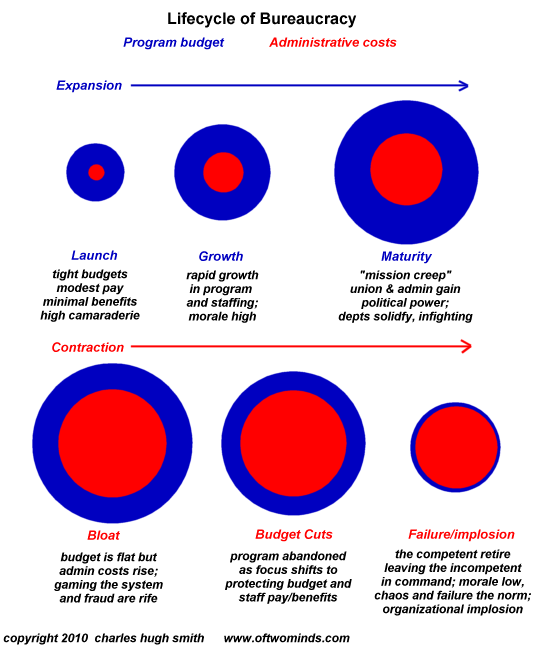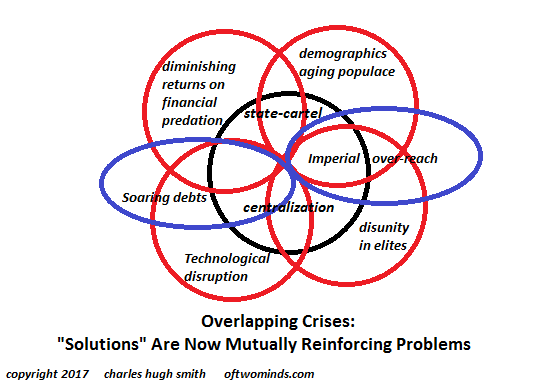The Pitfalls of Central Planning
February 21, 2024
If Central Planning can't expand its power, it expands its budget, at the expense of its programs.
Central Planning has an ominous totalitarian undertone, but there is a place for it in the social toolbox. The federal Interstate highway system was central planning, and so is Social Security. Many view America's patchwork electrical grid as not serving the national interest or its citizenry, and a dose of central planning to expand the grid's resilience and capacity might be the best way forward.
But like all tools, central planning has intrinsic limits and flaws. In
The U.S. Housing Market: Rent-Serfs and Artificial Scarcity and my weekend Musings Report for subscribers, I laid out the fatal flaws intrinsic to unfettered markets.
The point is there is no "magic solution" that works in all situations, places and times, and it's folly to seek one "fix" to every problem.
Humans are drawn to simplified, inspirational stories, and so both "the market" and "Central Planning" appeal to our desire for simplistic, idealized solutions to complex problems. While these are presented as polar opposites, they're both cut from the same cloth: simple. easy-to-grasp ideas that lend themselves to the quasi-religious devotion of true believers.
When each simplified solution fails, true believers always conjure up an excuse, or point out a detail that derailed the "perfect solution." Fix that, they claim, and it would have worked perfectly.
But the flaw is never an easily modified policy tweak; it's intrinsic to the "solution" itself. Just as markets lack mechanisms to recognize, much less price in, externalities and internalities that manifest in the future in complex ways, Central Planning has intrinsic fatal flaws that I described in my book
Resistance, Revolution, Liberation.
The ontological imperative of Central Planning is to view the expansion of state power as the solution to every problem. This expansion of power comes at the expense of some other node of social-economic power such as local governments, enterprises and social (i.e. non-political) organizations such as community hospitals, charities, commissions, etc.
This intrinsic imperative to ceaselessly expand regardless of how many failures pile up manifests in a number of ways. One is that the agencies of central planning never close down because they solved the problem they were launched to address: the agency either expands as a reaction to its own abysmal failure to solve the problem, or it engages in mission creep and declares its success grants it the right to start solving other problems beyond its original charter.
This is the organizational equivalent of the Peter Principle: every agency rises to the highest level of its incompetence, and then proceeds to expand its reach and power as the solution to its incompetence.
Central Planning is in bed with corporate monopolies and cartels, the private-sector equivalent of centrally organized, power-hungry agencies. Corporations grease political fundraising, and are "helpful" when retiring bureaucrats need a lucrative second career as lobbyists, board members, etc.--the infamous revolving door. It's a match made in Heaven.
If Central Planning can't expand its power, it expands its budget, at the expense of its programs. This process--the decay from idealistic can-do to self-serving muddle-through--is depicted in the Lifecycle of Bureaucracy chart:

Just as markets require limits, transparency and competitive oversight to serve their intended function, so too does Central Planning. Which of these overlapping crises is tailor-made to be solved quickly and efficiently by Central Planning?

How about state-cartel centralization? Oops, that's the problem, not the solution. How about imperial over-reach? Umm, well... or soaring debt? Ahem, cough... the source of the problem isn't the solution.
My recent books:
Disclosure: As an Amazon Associate I earn from qualifying purchases originated via links to Amazon products on this site.
Self-Reliance in the 21st Century print $18, (Kindle $8.95, audiobook $13.08 (96 pages, 2022) Read the first chapter for free (PDF)
The Asian Heroine Who Seduced Me (Novel) print $10.95, Kindle $6.95 Read an excerpt for free (PDF)
When You Can't Go On: Burnout, Reckoning and Renewal $18 print, $8.95 Kindle ebook; audiobook Read the first section for free (PDF)
Global Crisis, National Renewal: A (Revolutionary) Grand Strategy for the United States (Kindle $9.95, print $24, audiobook) Read Chapter One for free (PDF).
A Hacker's Teleology: Sharing the Wealth of Our Shrinking Planet (Kindle $8.95, print $20, audiobook $17.46) Read the first section for free (PDF).
Will You Be Richer or Poorer?: Profit, Power, and AI in a Traumatized World
(Kindle $5, print $10, audiobook) Read the first section for free (PDF).
The Adventures of the Consulting Philosopher: The Disappearance of Drake (Novel) $4.95 Kindle, $10.95 print); read the first chapters for free (PDF)
Money and Work Unchained $6.95 Kindle, $15 print) Read the first section for free
Become a $1/month patron of my work via patreon.com.
Subscribe to my Substack for free
NOTE: Contributions/subscriptions are acknowledged in the order received. Your name and email remain confidential and will not be given to any other individual, company or agency.
|
Thank you, Anthony A. ($5/month), for your magnificently generous subscription to this site -- I am greatly honored by your support and readership. |
Thank you, Jay S. ($5/month), for your marvelously generous subscription to this site -- I am greatly honored by your support and readership. |
|
|
Thank you, Daniel T. ($54), for your splendidly generous contribution to this site -- I am greatly honored by your support and readership. |
Thank you, Ryan T. ($5/month), for your outrageously generous subscription to this site -- I am greatly honored by your support and readership. |